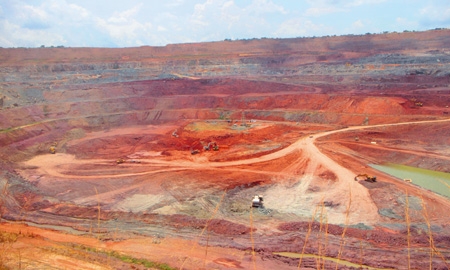Angola might be better known for its oil reserves but the emergence of its huge mineral resources is increasingly sparking international interest.
More than a decade has passed since the end of conflict in Angola and today the country is focusing on developing both its wider infrastructure and ability to attract investment into the mining sector. The land on which Angola lies is rich in mineral stores.
Minister of Geology and Mines Francisco Manuel Monteiro de Queiroz says that much of the early work to develop the country’s infrastructure came from Chinese investment. “They came with a clear strategy, aimed at the future, and money was the only thing we needed,” he says. “China opened a credit line to Angola, to pay on a long-term basis, and we began the work. Angola invested this money in infrastructure, with excellent projects in education and healthcare, which are slowly becoming self-sufficient.”
That investment has helped Angola to further explore its natural resources. Covering an area of 1,246,700 km2, the country holds the potential for discovering a huge number of opportunities that currently remain locked underground. To deal with this, the Angolan government has introduced a National Geology Plan, which includes a mapping process – “mapeamento” – that intends to document the country’s resources.
“Afterwards, we intend to make everything we find out public, and start to attract national and international investments to exploit these areas,” says Mr Queiroz.
As ever, it is the indefatigable diamond that has caught much of the attention, which is not surprising given the huge quantities that are mined each year. Angola is Africa’s second biggest producer of the stones in terms of sheer quantity, which account for around 5% of the country’s GDP. Over 90% of the diamonds mined are estimated to be of gem quality and the African country is the world’s fifth highest producer in terms of value.
Major producers include state-owned Empresa Nacional de Diamantes de Angola (Endiama), which produced 8.3 million carats in 2012, but the country’s biggest firm is Catoca, which is part owned by Endiama and Russian company Alrosa. It has been investing heavily over recent years to both increase efficiency, by purchasing more prospecting and production equipment, and to expand its reach with new projects, including concessions at Vulege, Catoca and Luangue.
| New legislation means that the state now must have a minimum stake of just 10% of mining ventures and prospectors are being encouraged with reduced red tape and lower taxes |
While diamonds catch the eye, the mining industry in Angola has also been turning its focus to different mineral industries, including copper, granite, marble and gypsum. The latter of these was first produced in 2009 and has since attracted foreign investors looking to expand in Angola, such as the Irish company Aurum Exploration Services.
Last year, Mr Queiroz told delegates at the Japan Sustainable Mining, Investment and Technology Business Forum in Tokyo (J-SUMIT) that the country has an array of projects requiring investment, covering industries including copper, platinum, nickel and gold.
The ongoing expansion of the country’s mining sector does not look set to let up anytime soon. The government has pencilled in an increase in diamond production of 5% year-on-year and is also pushing to see additional services provided, such as the creation of jewellery firms and polishing companies.
Elsewhere, the creation of the mining charter, which was passed into law at the end of 2011, has helped fuel interest and growth in the mining sector. The legislation means that the state now must have a minimum of just 10% ownership of mining ventures, versus a majority ownership stake stipulated previously.
It also introduced extensive rules around environmental impact. It has cut down on red tape for prospectors to enter the country and set up their operations, and reduced taxes: corporate income tax for mining firms has dropped from 35% to 25%, while investment income tax is between 10% and 15%.
With a defined charter and new laws that help facilitate investment and expansion, Angola is looking to provide growth opportunities and security for both investors and its own population.
Miguel Bondo Junior, Secretary of State for Geology and Mining, explains: “The Mining Code provides a favourable environment for investment in mining. Instruments such as the National Geology Plan (Planageo) will allow us to know the true mining potential that we have, and to transfer this knowledge into wealth through the creation of mines, jobs and training, contributing to the general state budget and national GDP to ultimately improve the life of the population.”
The government is keen for more foreign investment to enter the country from the likes of European partners in Germany and to expand projects with firms in countries such as Brazil and Australia. However Mr Queiroz stresses the government’s insistence that the deals struck must benefit both the foreign firms and the local Angolan population, as well as reflect a sense of partnership.
President José Eduardo dos Santos has already invested in new public projects across various sectors of Angolan society, including in healthcare and education.
Mr Queiroz says that foreign firms looking to work in the country need to keep such social responsibility programs in mind.
“Infrastructure, healthcare, education and the environment have to be taken into consideration in relationships between the countries that sell and countries that buy those resources. We need to work out relationships that will create positive aspects for underdeveloped countries with massive amounts of resources to offer, in collaboration with buyer countries,” he says. “We need to create conditions so countries like Angola can compete in the market while being fair to economies that need our resources.”

0 COMMENTS